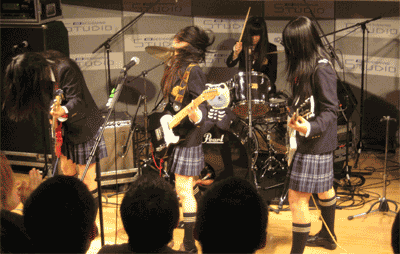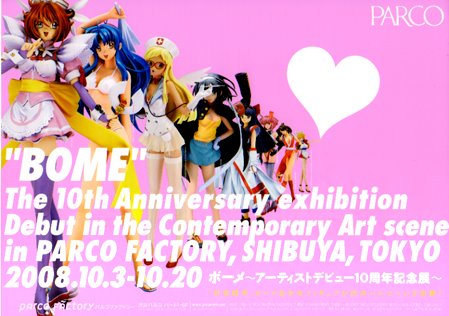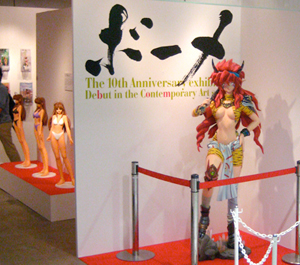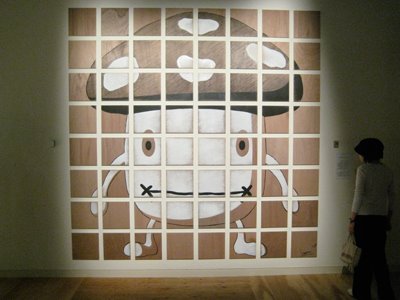
"Rock'n'Roll High School" by the Ramones blasts from the speakers as four Japanese girls in high-school uniform come on stage. It couldn't be a more perfect song to introduce this band to the waiting press.
Scandal are young, sexy, and have a gimmick that may just carry them to international stardom. As I've pointed out before, there is something magnetic about metal performed by Japanese high-school girls wielding guitars like pros. Maybe it's because long black hair is made for head banging, or maybe it's the tartan skirts? But the school uniform and rock formula is something that works. Just ask Angus Young from AC/DC, and he's nowhere near as sexy. Comparisons to the band in the film Linda Linda Linda are also inevitable. But Scandal are the real deal, they got their start playing live on the streets of Osaka, and three of the girls are actually still in high-school; the forth, the lead singer Haruna, is only 20. They're fresh, young and really look like they enjoy what they're doing. They play like they love rock and with their 70s rock hair, and Fender and Gibson guitars, they have all the trappings of a rock band, including lots of groupies... male groupies.
Their fans are a bit of a worry actually. At the moment they're the same kind of awkward guys that like to dance along with syrupy Akihabara street idols. They're very uncool, and an association with them may be to the bands detriment. It's easy to see why otaku are attracted. Schoolgirl uniforms are a major fetish for these guys, but unlike the glut of so called "idols" out there catering to the otaku dollar, these girls actually have talent. They can really play, and really do rock out live.

But Scandal is going to have to break free from the otaku ghetto if they are going to be taken seriously. They may need to rock even harder to release themselves from their current fan base. It may be overseas that they find their true rock creds by following in the footsteps of Japanese bands like Shonen Knife.
They also need a better producer. These girls are way better live than they are on their CD, which has been mixed as if they were light weight J-pop stars. It totally caters for the otaku audience, but when they play live their sound is much bigger and more raw. It's a shame that the energy of their live show is diluted on the CD. It could be much better, and if they are to succeed overseas they need better producer, one who knows how to deal with rock.
Ditch the otaku fans I say and get the Indy fans behind you. Scandal have already played in the States and may return to play at the South by Southwest festival next year. Keep an eye out for them.
Here's their latest single, "Doll":
27/10/2008
More JSG Rock
17/10/2008
Bome vs Docomodake
I caught a couple of exhibitions last week, one by chance and the other less random; but both were linked by the fact art in Japan these days often has its roots deeply buried in corporate-pop-culture. We probably we have Takashi Murakami to thank for this. Him and his grand Superflat theory—that Japanese don't traditionally make distinctions between "high" and "low" art—have sure made it easier for artists and corporations to come together and produce art for the masses. Populist, fun art that seems easy to understand. But art that doesn't challenge the viewer too much. Branded, corporate art that sells for a fortune; but with copies mass produced to sell in toy stores. Art that's given away with a mobile phone. It's art for everyone, but no one in particular.
I stumbled across the first exhibition in Shibuya when I noticed a bright pink poster advertising a show by BOME—who can most simply be described as a sculptor; a very otaku sculptor. In Japan Bome is best known for his sexy three dimensional figurines of anime-style girls, including the Monseiur BOME series of collectible figurines from Kaiyaido. These are sexy dolls for pervy boys; of big-busted babes with ridiculously long legs. They're the 6 inch girlfriends of otaku (to quote Patrick Maccias). And they seem almost, how can I put this? Possible.
Bome's skill is taking the absurd proportions of women in the two-dimensional world of anime and manga, and transforming them into glorious, eye-popping 3D. This is why he has so many fans; because he has overcome what otaku call the "three-dimensional contradiction" that the girls who exist on the pages of manga could not possibly exist in the real world. The weight of their breasts alone would mean the poor girls' backs would give out! But somehow, Bome's figures pull it off and the illusion of possibility is what makes these dolls such a tease. This skill is also what caught Takashi Mukrakami's eye many years ago.
With the help of Murakami, Bome's work has managed to emerge from the dark geeky ghetto of figure-collecting otaku into the glare of the international art world. And ever since 2003 when his 1997 collaboration with Murakami—a sculpture called "Miss ko2 (Project ko2)"— fetched US$567,500, the highest price ever paid for a piece of contemporary Japanese art at the time, Bome has been known overseas as an artist to keep an eye on. The show at Parco Factory is billed as the 10th anniversary of the artist's debut into the contemporary art scene, but it's essentially a show for otaku. Many of Bomes original figures are on display, and from his most early work in the 1980's to the most recent work it's fascinating to see the development of his technique. There are videos showing interviews with him and there's a detailed, step-by-step display of how he makes his dolls. But the best part of the whole exhibition—and the thing that brings all the high-falutin talk of his art world connections back down to earth— is that you can buy the mass produced versions of his figures in the gift shop, for about 4000 yen each.
The second show I went to see was a much more blatant corporate art show, but one that ironically had art of a more traditional taste, and very different flavour. "How to cook a Docomodake" is a collection of work by sixteen artists who were invited my the mobile phone company NTT Docomo to produce art that was inspired by the company mascot, a mushroom called the Docomodake. The exhibition first showed in October 2007 in New York, and was a very clever way for Docomo—who are not at all well known in the US—to introduce both their brand and their popular mascot. In Tokyo the character needed no introduction and the show was still packed when I went to see it on the closing day. 
Essentially all the artists involved had deconstructed the well known character and presented it in their own way. Rika Eguchi, presented the Docomodake served up as if cooked in different ways, grilled, sliced, diced and rather over-cooked. This work was the most "cute" of all the work there, but not the best. My personal favourites were the detailed, psychedelic, pencil drawing by KYOTARO entitled "The Sleeping Forest" and of course "Yokai - Japanese Ghost - Dokomodake" by MUSTONE (pictured above). I also really liked the jacket and skirt by ANREALAGE, who has taken apart hundreds of stuffed Docomodake toys, including the small "screen-cleaner" versions that hang off people's mobile phones, and sewn them together to make his patchwork fashion (below).
Both these exhibitions could be criticised by a more serious art critic for being shallow, and vapid extensions of a post-modern society that doesn't quite know how to stop feeding upon its own pop offspring and start producing meaningful art again. But I liked it.
"BOME" The 10th Anniversary exhibition Debut in the Contemporary Art scene in PARCO FACTORY, SHIBUYA, TOKYO runs until October 20th, 2008
How to cook a Docomodake was at the Intercommunication Center at Tokyo Opera City but ended on October 13th, 2008
01/10/2008
Alone in Shibuya
I found a good place to sit and watch. From a seat near this bar's window, I can see Shibuya passing me by. Opposite me there's an Excelsior Caffé that I know, from personal experience—and a somewhat obsessional love of good coffee—fails to excel in café. Beside that there's an entrance to a basement bar that's advertising cheap beer. A black guy stands there, waiting for customers, and occasionally breaks into dance. Break-dancing. Moon-walking-robot-style; seriously old-school. In front of him, on the sidewalk, are three men, two black, one Japanese, and it sure looks like they are passing a blunt. The police Koban is about one hundred metres away. Next to the cheap-beer-hip-hop bar is a Zara, and girls walk by looking at the mannequins in the window. It's raining, which is when I Iove Shibuya best; wet—neon reflecting in the puddles on the street. Umbrellas up, shielding the faces of all the girls with great legs, leaving me to wonder just how wonderfully gorgeous they are. Reflected in the second floor window of the Excelsior Caffé is a Big Echo karaoke place—a big reflected echo. Other signs add an expressionistic chaos of colour to the slick wet asphalt; the "Italian Tomato Cafe Jr.," and the "Curry House CoCo" send an aromatic mixture of curry and garlic into the damp air. A girl posts a letter in a tomato-red mail box as couples walk by, and the two girls sitting next to me light two more cigarettes. They are talking about their friend, who "is so beautiful she looks like a foreigner," and I wonder about the different eye's of the beholder, as mine scan the girls out the window, and the beautiful ones are beautiful maybe because they are foreign, to me. A white guy wearing a red-and-white shell-suit is lingering near the hip-cheap-hops bar; red baseball hat worn backwards, he's trying so hard to get "down" with the black guys clustered there. He's weedy, small, dangerous in his intense desire and looks like a dealer, an East London dealer, twitching, nervous and keen. He tries to lure passing girls with his imagined ghetto charm and fails. Now he's leaning alone against a wall. Now he's alone beneath a clear umbrella. Perhaps he works cheap for the hip-hop beer. Opposite him is a smooth black gentleman in a suit-and-tie and the contrast between the two is culturally amusing. The smooth dude is emailing someone on his mobile. The girls next to me have gone. And my glass is empty.






